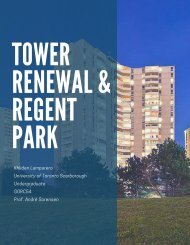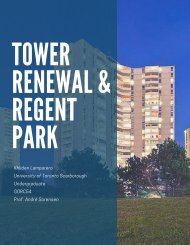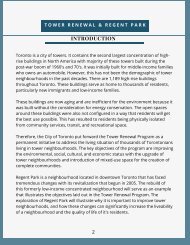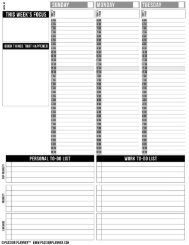Tower Renewal & Regent Park Final
Create successful ePaper yourself
Turn your PDF publications into a flip-book with our unique Google optimized e-Paper software.
<strong>Regent</strong> <strong>Park</strong> was a very good example of tower neighbourhoods in Toronto. It was built in<br />
1949, and is now home to thousands of newcomers from diverse ethnic backgrounds. This<br />
diversity can be seen with the number of languages spoken in the neighbourhood, where over 60<br />
different first languages are spoken. Poverty was a big problem in <strong>Regent</strong> <strong>Park</strong>. Almost<br />
everyone was living in poverty and 73% of its adults were underemployed (CRC, 2015). The design<br />
and layout of the buildings was also another crucial issue. Looking from the air, the buildings<br />
looked neatly arranged, but from the street level, it was certainly not pedestrian-friendly. The<br />
buildings were built facing inward and away from the streets, supposedly to promote safety, but<br />
has ended up creating an isolated and crime-ridden neighbourhood. The open<br />
space was also underused because it was mostly surface parking lots. These parking lots do not<br />
serve this community because only a very small number of the population own a vehicle.<br />
People rely on public transit. However, public transit was not accessible because they<br />
were no routes passing through this neighbourhood. This urban design created opportunities for<br />
crime and gangs to develop, and it created a bad reputation due to its very serious drugs and gang<br />
violence problems.<br />
Aerial view of <strong>Regent</strong> <strong>Park</strong> before the revitalization,<br />
Torontohousing.ca<br />
However, even with the negative social<br />
situation, there was still a strong community of<br />
residents who looked after each other. Tired of<br />
their situation, the residents advocated for the<br />
revitalization of their neighbourhood in<br />
1995. In 2002, the City of Toronto created the<br />
Toronto Community Housing Corporation<br />
(TCHC) as the largest social housing provider in<br />
Canada, and second in North America. In 2003,<br />
the City with the TCHC made a plan to<br />
redevelop and revitalize <strong>Regent</strong> <strong>Park</strong> over the<br />
next 15 years.<br />
Demolition of all 2083 housing units began in 2005. In 2006, the City of Toronto selected the<br />
Daniels Corporation, a private developer, to serve as the role developer of <strong>Regent</strong> <strong>Park</strong>. However,<br />
Daniels is still subject to City of Toronto plans, as the city serves as <strong>Regent</strong> <strong>Park</strong>'s master planner.<br />
<strong>Regent</strong> <strong>Park</strong>'s revitalization introduced a mixed-used, mixed-income community that erased the<br />
stigma of poverty. The demolished buildings were replaced with newly built, energy efficient<br />
subsidized townhouses and mid-rise buildings that resemble market-value houses to change public<br />
perception of what public housing should look like. The revitalization also allowed for the change in<br />
street configuration and land-use zoning. Due to the Residential Apartment zoning bylaw,<br />
commercial activities were not allowed in the neighbourhood, but the revitalization of <strong>Regent</strong> <strong>Park</strong><br />
allowed for the change in street configuration and land-use zoning. Now there are businesses such<br />
a Fresco, Tim Hortons, Royal Bank of Canada, Main Drug Mart and Rogers in the neighbourhood.<br />
7








